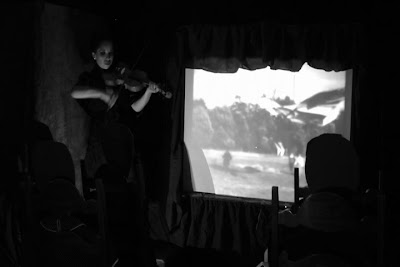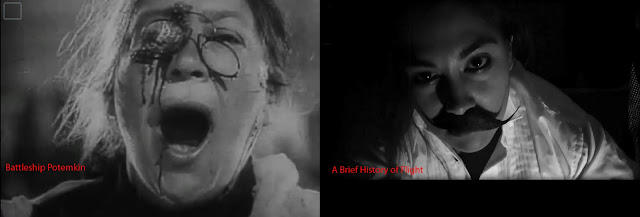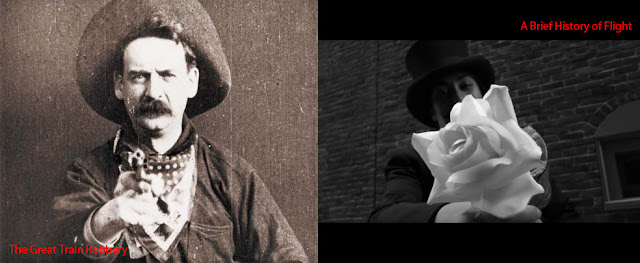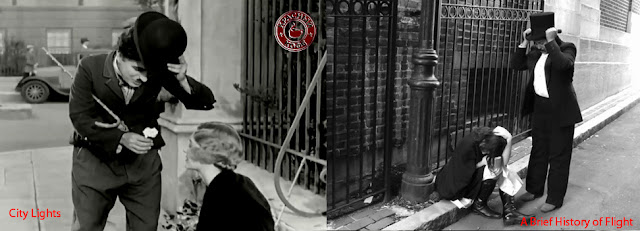Why would someone want to make a silent film in 2012? The Story of The Michael J. Epstein Memorial Library’s “A Brief History of Flight”
We all have a desire to escape that which imprisons us, and this inspires us to seek powers that exceed our natural capabilities. The word “flight” has a double meaning – both the fantastic and glamorous ability to take to the air and the shame and fear of retreat or escape. If I had to summarize it in one sentence, it is hubris, vengeance, and consequence; all inspired by metaphors of flight.
It all started with the idea that the supernatural forces in the story are delivered by a character known as The Violinist.
Full Film
Trailer
 |
| Susannah P as The Violinist, performing to a surrealist’s cardboard audience |
The Violinist
It goes back a few years…to my grandfather, Frederick Epstein (1908-1988). I didn’t have any opportunity while he was alive to have serious conversation with him about music, but I do know that he played the violin, and, according to my father, aspired at some point to build a career playing live accompaniment to film. (It wasn’t really until the 1930s that “talkies” took over.) While I don’t know that this career “change” had significant impact on my grandfather, I thought it was the same kind of fascinating transition as industrialization and the reduction of manual labor in favor of machines. In fact, I always remembered the Disney Paul Bunyan cartoon in which Paul and Babe the blue ox are defeated in a logging contest by a steam-powered saw and found something sad about it. Sure, the cartoon ends with Paul and Babe having fun instead of laboring, but it was clear that, although they were unstoppable giants, their time had come. I imagined the same sort of tale for a violinist so powerful, his playing was hypnotic. The experience of the film was more about his bowing than about the images accompanying it – a reversal of purpose of sorts. This inspired the song, “The Violinist.” I had written the song during the time when The Motion Sick was active and we had played it quite a lot live, but never finished a recording of the song. It explored the legend of this character, so powerful that it was unimaginable that he could be replaced by sound pictures…but he was.
The lyrics:
and giant men they whisper
for giant men don’t scream
and giant faces dither
out of the ether stream
and silent women shiver
and silent women dream
and silent faces wither
back to the ether stream
Back in a smoky corner
he bows his violin
the lost all gather ’round him
hear God absolve their sins
he will absolve their sins
oh God absolve my sins
Giant men they point their weapons
the horses buck and rise
tears across a screeching vengeance
fists raised up to the sky

Silent Film
The Violinist’s context and association with silent films made me really want to tell the story of The Violinist in silent-film form and with a pacing and narrative that resembled silent film. I was inspired by the feel of films like Sergei Eisenstein‘s Battleship Potemkin (which arguably is the first film cut in a modern manner – I rewatched it the night before shooting for inspiration), Fritz Lang‘s Metropolis, Charlie Chaplin‘s City Lights, Edwin Porter‘s The Great Train Robbery, and of course many others including the numerous works of Cecil B. DeMille and Buster Keaton, F.W. Murnau’s Nosferatu, and the emerging surrealist film movement.

Early film fascinates me because of the vast differences in pace, storytelling style, and limitation. I wanted to make something now that paid tribute to those early films and toed the line of keeping the pacing and cutting just modern enough to interest a relatively wide audience. I borrowed mostly superficial elements from early film – the to-the-camera expressions and reactions (elements of The Odessa Steps sequence in Battleship Potemkin, for example), the type of limited, but effective special effects used in Metropolis, the physical absurdity and comedy of Chaplin and Keaton, and the audience as target action of famous closing shot of The Great Train Robbery.

In a filmmaking note, I also became very interested in film running backwards when my father would show me a Batman serial film that he would project using a 16-mm projector and would reverse direction periodically, making the characters and action run backward, much to the delight and surprise of 6-year-old me. There is something disconcerting and nervously humorous about seeing things in reverse. I used that in this film to elicit sort of uncanny feelings in some sections.
The Story
I sometimes become obsessed with particular songs or stories. I rewrite them, recontextualize them, and just repeat them in my head until they finally wash away. One particular song of obsession many years ago was The Legendary Pink Dots’ “Lisa’s Separation.” The first half of the song is about a woman who has been abandoned by her lover. She destroys everything that reminds her of him including her oeuvre, made in his likeness and honor. In the second half, we learn that he was actually murdered and that his ghost watches over her all the time as he desperately tries to explain, to no avail, that he did not run off. Something about this story led me to begin writing my own story based around this idea of abandonment. I held to this concept of the ghost, both free and shackled, protecting her, but with no real ethereal powers to change physical events or spaces. In my version, however, there is no innocence; no Lisa. Just those guided by fate, powerless to change their actions.

My plot focused on a well-to-do inventor who believes he can accomplish anything. He is sure that he can turn the life of a destitute young lady around. He woos her and takes her in, only to have her flee after he takes her on a flight that defies human limitation. Once he hunts her down, he realizes that she is involved with a crowd that is a little more than he had bargained for. He is stabbed and as he nears death, he seeks out the mystical powers of The Violinist, restoring life, but not without cost. He is given breath only to avenge the acts against him. As he seeks out those who wronged him, he encounters his love interest, and filled with vengeance, almost against his will, he kills her. Together, their worlds crumble.
The Film
We shot the film in 2 days (the coldest two days of the entire winter!). It was all of the time we had to get it ready for the private screening. I had only a few days after to edit it and we presented it live with musical accompaniment (and some backing tracks that first time). Since then, I’ve had the opportunity to further tweak the edits and we made the public live debut of the film and accompanying performance (with no backing tracks) on June 15th at TT’s!
Tanya, Rachel, Susannah, Jane, and Sophia did a beautiful job crafting their characters and delivering performances that made the film easy to cut together. I was really impressed, particularly given how little collective acting experience they all have. They are just naturals!
The Original Idea
The plan was for the next project by The Motion Sick to be an exploration of these themes in song and in a short film. I was obsessed as a young person with Edward Gorey’s “Mystery” opening sequence and had always wanted to make something in that style. After exploring the possibilities, we realized it would be too expensive to realize and as the band started to wind down and become less active, we trimmed it to a 4-song EP (losing much of the themes), which we haven’t yet finished.
The original film/album was to be called, “A History of Flight,” and was to contain:
1. Winged Bicycle (older Recording) – 2. Disappear (live video) – 3. The Violinist (live video) – 4. I Will Build A Helicopter (live video) – 5. Oh Emily (MJEML version) – 6. Holy Ghost (MJEML version) – and two songs that have never been finished: 7. A Brief History of Flight and 8. Fade Away (Explode)
When the opportunity arose to make a short film with The Michael J. Epstein Memorial Library for a special event, I immediately thought perhaps we could create a modified live-action version of the story. It made sense. We had already been playing a couple of the songs originally intended for inclusion in the tale, and the only song that I thought we absolutely couldn’t go without that we didn’t know was “The Violinist.” At first, I considered abandoning the flight theme all together, but, even without the accompanying songs, we decided to keep that element.
[…] Full album: https://music.michaeljepstein.com/album/the-art-music-exchange The song originally was put together for a scene in the MJEML’s silent film, “A Brief History of Flight” […]
[…] and, in keeping with my trend of killing her off in everything I make (see here and here), will probably play one of the fallen in […]
[…] release date)*2012 – The Violinist Single – Lyrics/Chords – Additional Info – Buy: Bandcamp, Amazon, CDBaby – Listen: Spotify, Youtube *2012 […]
[…] The Michael J. Epstein Memorial Library – we made so much music this year! Let’s go by month! In January, we shot and premiered a 20-minute silent film set to our music at an ORG party called, A Brief History of Flight! We played to the film live once more at TT the Bears in June. And here’s the whole story of the film and why we made it! […]
[…] The full film is out. […]